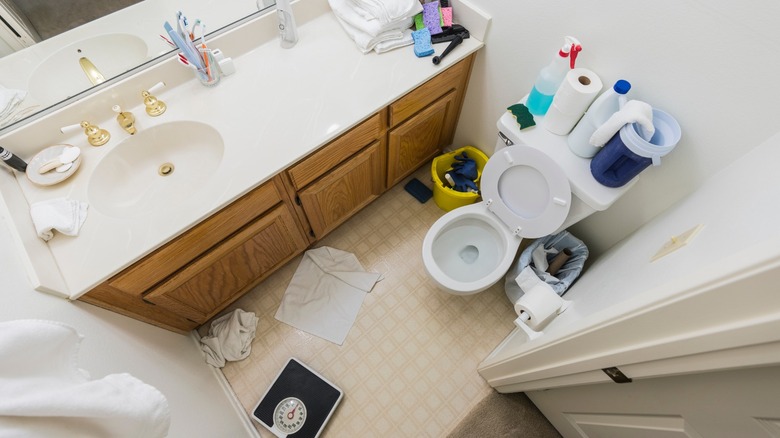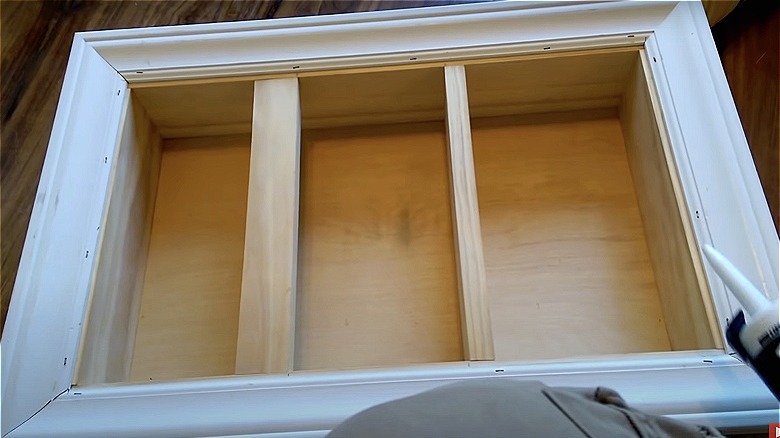TikTok's Recessed Shelving DIY Adds More Storage In Tight Bathrooms
We may receive a commission on purchases made from links.
When distributing space within a home, bathrooms often end up with the short end of the stick. This is primarily because these rooms are viewed as purely functional areas meant for basic routines like brushing teeth, using the toilet, and bathing. However, space is just as crucial for bathrooms since insufficient space can lead to an uncomfortable, cramped experience. In addition, bathrooms quickly get cluttered with hygiene and grooming essentials. This is why many people look for storage solutions for their tiny bathrooms. However, not all spaces can accommodate additional racks and cabinets. If this is you, why not try DIYing a recessed shelving similar to what Brandali Radulovich of @eternalharvestdecor on TikTok has done?
A recessed shelf sits right in the wall, so it doesn't decrease your precious bathroom space. Its space-saving design provides additional storage, helping to reduce clutter around your shower area or window sills. With a recessed shelf, you can eliminate the need for storage racks and bathroom caddies that often make the space feel crowded. Beyond its practical benefits, a recessed shelf also offers a decorative touch to a small bathroom. It's a perfect spot to display succulents or decorative items, adding personality to the room.
How to cut through a wall for a recessed shelf
Wall studs are usually spaced either 16 or 24 inches apart, providing an ideal location for your shelf. However, caution is needed regarding wires and plumbing, as light switches and electrical outlets are frequently installed alongside these studs. This makes it crucial to find your wall studs. Once you have identified them, mark their positions for reference. Following this, you need to confirm no electrical wires or plumbing are behind the drywall you plan to remove for your shelf. Ensuring this avoids potential damage to these utilities and makes for a safer installation.
While stud finders that also detect wires can be helpful, they're not foolproof and may sometimes give false positives. To ensure there are no hidden electrical or plumbing lines, create an inspection hole and use a mirror and a flashlight to examine the area behind your drywall for any wires or pipes before making a more significant cut. Some stick out their phone cameras and take images from all sides. If you want to avoid making a big hole, copy what Radulovich did. She drilled a small hole and inserted a scope (available on Amazon for $19), which was connected to her phone so she could easily see what was inside. The scope was bendable, came with a light, and was small enough to fit easily into the hole, allowing her to easily inspect the back of the wall before cutting it.
How to make a recessed shelf for your tiny bathroom
Once you've thoroughly inspected the back of the drywall, you're ready to create your built-in shelving from scratch! Plan out the dimensions of your shelf by tracing an outline of it, and then use a drywall saw to cut it out. As demonstrated by Radulovich in her TikTok, frame the cut-out area by fixing appropriately sized boards to the studs surrounding the hole. The piece of drywall you removed can be repurposed as the back panel of your shelf. Once the basic structure is in place, use putty to fill gaps and smooth the seams. Sand, prime, and paint the entire thing before adding the shelving.
If you prefer a more straightforward approach, construct a box shelf to fit the dimensions of your recessed area. This box should include a back piece, sides, shelves, and a lip that extends over the wall. After assembling the box, use putty to fill any imperfections and seams, then sand, prime, and paint it. Once ready, fit this box into the wall niche and securely attach it to the studs. This method allows for a more uniform and straightforward installation process.

